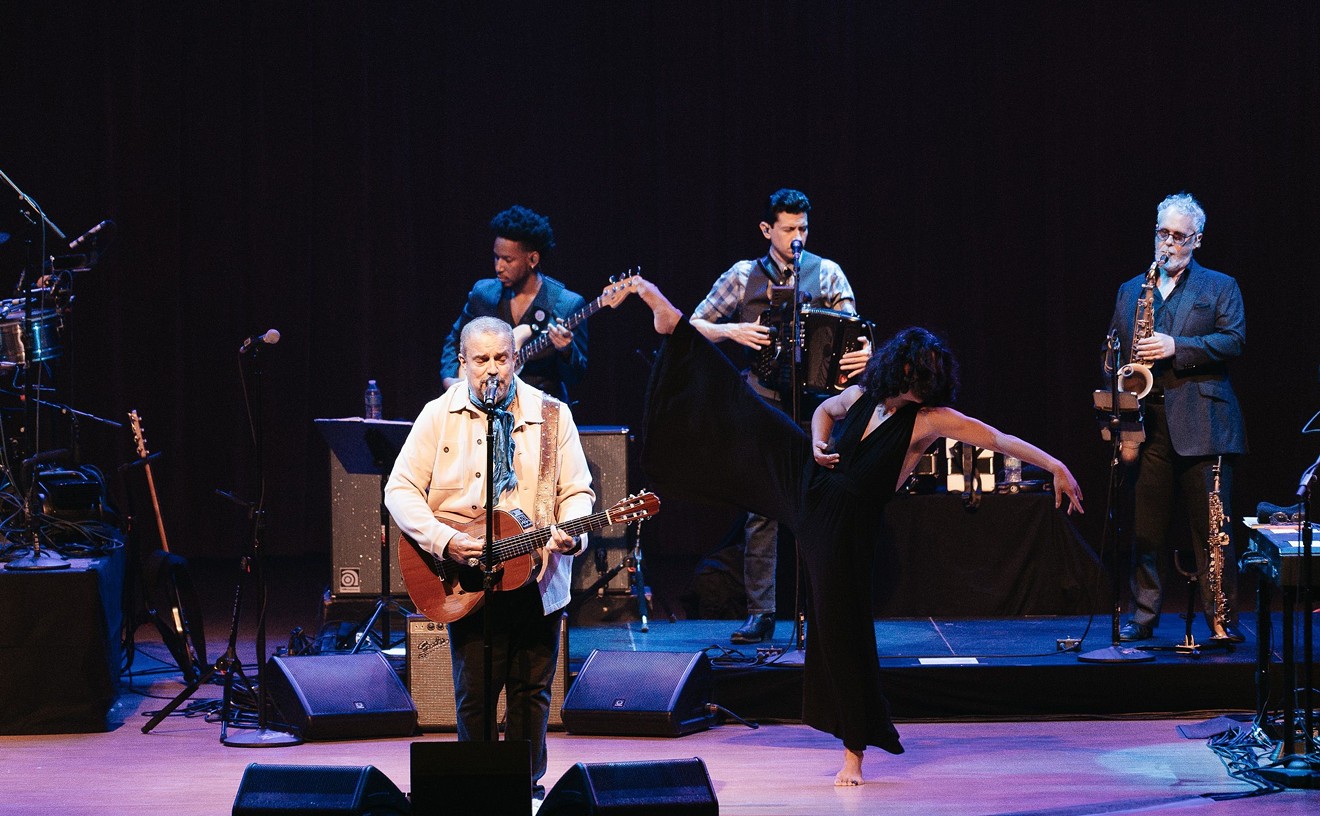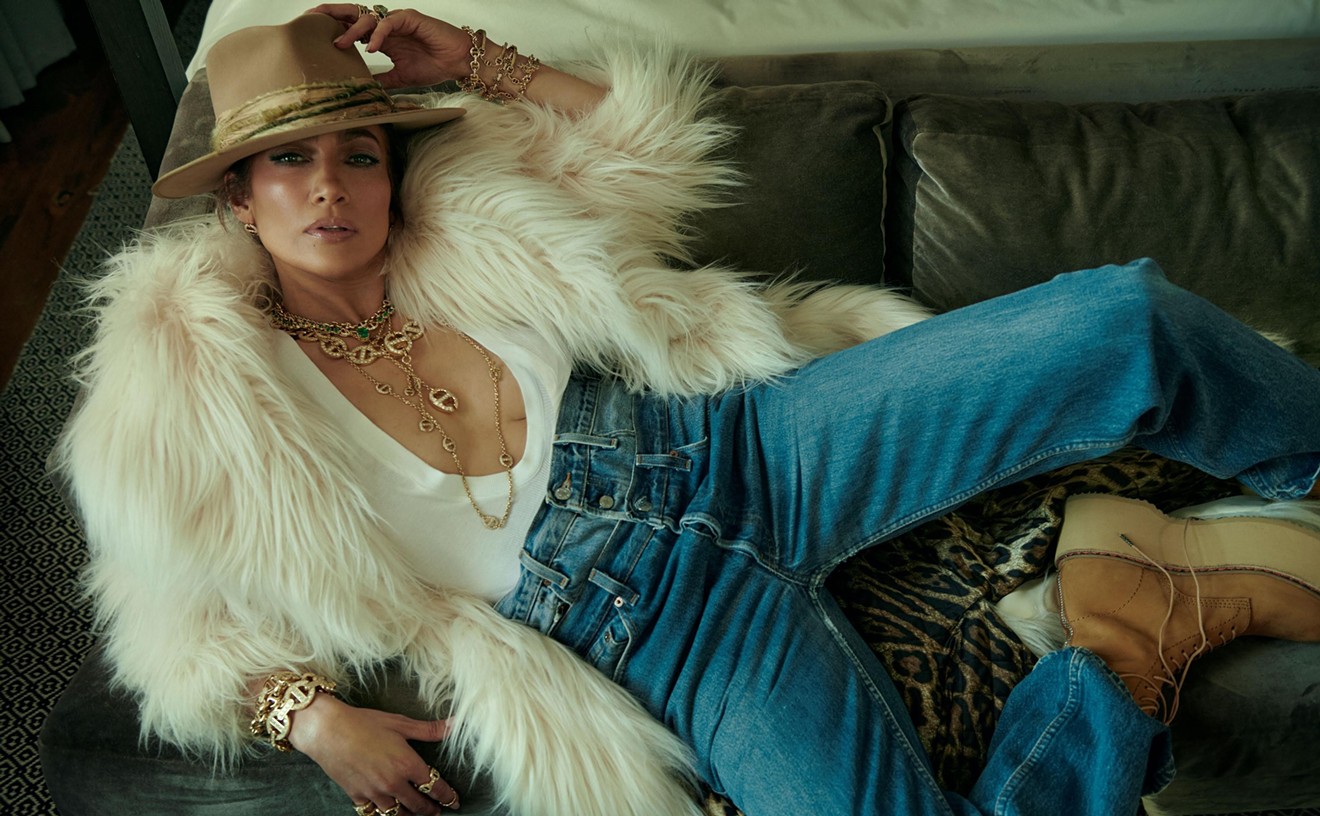The revered black-and-white cover art on Black Flag's 1981 EP Six Pack features a teenaged boy hunched over in a corner, as if in an asylum, sitting with his arms crossed over his knees. Its most unsettling aspect: His face bears a maniacal "Heeere's Johnny"-type smirk. With images like this, artist Raymond Pettibon, brother of Black Flag's Greg Ginn and creator of the punk band's famed four-bar logo, visually captured the spirit of early California hardcore.
Six Pack boy has painted himself into a corner. But instead of a thick, uniform coat, in an appealingly abstract twist, the paint job takes on a smudging-shit-all-over-the-floor aesthetic.
"It's so creepy!" exclaims Chuck Loose, cofounder of Fort Lauderdale print shop Iron Forge Press. While admiring the cover in his office — the back of a shipping container sitting in a high-ceilinged warehouse with hundreds of concert posters by Iron Forge artists on the walls — Loose largely credits Pettibon with inspiring him to explore oddball art.
"My mom used to periodically go through my room and rip down my drawings of skulls and boobs," Loose says, laughing. "[Pettibon's work] was the first time I saw that you can draw this kind of stuff and get it published."
The Six Pack record sleeve, along with more than 200 other works by Pettibon, who is in New York preparing for a solo show at the David Zwirner Gallery, will be on display starting Saturday at Florida Atlantic University's Schmidt Gallery as part of "Raymond Pettibon: The Punk Years, 1978-86." Accompanying the exhibition will be "From the Gutter," a program chock-full of lessons in punk history. It includes lectures from FAU professors on subjects ranging from the sociological ("Reagan Youth: Black Flag in 1980s Southern California") to the artistic ("Cut and Paste: Typography, Violence & the Punk Rock Aesthetic"). "From the Gutter" will also feature screenings of topical films like 1987 skateboard-culture flick The Search for Animal Chin, which stars a very young Tony Hawk and Steve Caballero, and rare footage of an early Black Flag show shot by Pettibon.
"[The films] add a different perspective," says Shane Eason, who compiled the show's films and videos. "Although it's the same generation of people, you are still highlighting a set of marginalized filmmakers. These types of films were hard to see. You had to go to dirty punk clubs and viewing parties."
The obvious highlights, though, consist of Pettibon's concert fliers, album covers, skateboard art, and zine drawings. Like Six Pack's trapped-kid image, which conveys paranoia and confinement met by the gleeful satisfaction one gets when doing something really, really naughty, the rest of the works communicate a similar kind of nervousness — the kind one felt coming of age in the morally rigid era of Ronald Reagan. Hardcore served as an outlet for such tensions.
"The anger of the music and the anger of the aesthetic went hand in hand with the feeling of frustration with traditional political avenues," says FAU art history professor Eric Landes, who will present the lecture "Cut and Paste: Typography, Violence & the Punk Rock Aesthetic."
The cut-and-paste motif of much of punk art at the time, Landes says, coincides with young people's rejection of the political and social climate.
"It's not unique. You can find precedence in the early avant-garde movement of the interwar period of the 1920s and '30s, and I think those things cycle around when there is a need to politicize art," he says. "The cut-and-paste method denies authorship to a certain extent; it feels sort of populist. It's anonymous, and it's of the people."
While British hardcore grew out of a sense of disenfranchisement, its American counterpart grew out of a kind of listlessness. Many teens, bored in the ostensible paradise of sunny Republican California and various other hardcore hotbeds during the '80s, looked to the stripped musical aggression, ironic humor, and sociopolitical messages of the genre as something raw and real and completely opposed to their dull suburban existences. Hardcore, with roots in late '70s British punk bands such as the Fall and earlier California punkers like the Germs and the Avengers, provided a release by being harder, grittier, and nastier than its predecessors. All that tension had to be channeled somewhere, and why not a sweaty mosh pit?
"What makes the punk era particularly interesting to look at," continues Landes, "is that the clothing, like the printed material and the ephemera and the T-shirts and the album covers, all came out of this idea of a lack of training. Of a do-it-yourself approach to everything, including the music. So not only are the bands largely self-taught, even while some are more musical than others, the people doing the fliers and doing the artwork are also coming from a kind of self-taught perspective. There's a rejection of institution in general that goes along with it."
No band embodied that philosophy more than Black Flag. Anti-authoritarian attitudes and direct-action sensibilities defined a lot of the movement. But Black Flag's distribution through Ginn's label, SST, and its exhaustive touring and practice schedules put the band above and beyond its peers. The band didn't like the way the mainstream music community handled business — legal problems with Unicorn Records prevented Black Flag from releasing material under its moniker for a period — so a new system was created, even if it made life fairly unbearable. Pettibon's art was arguably the template for the record label and band that made hardcore what it is in the U.S.
"The art was hardcore," says Steve Toth of local band Mr. Entertainment and the Pookiesmackers. Toth first saw Pettibon's work in the gatefold of Double Nickels on a Dime, an album by SST band the Minutemen. "It was like an introduction to abstract thinking. Like reading people's thoughts on the paper. You weren't always sure if the character was thinking or saying something."
Black Flag and its fans could always expect to encounter harassment from police, provoked or not. Likewise, the appeal for many "fans" was an oversimplified interpretation of hardcore as fundamentally violent. Thus, eventually and unsurprisingly, Black Flag shows became synonymous with fights and riots.
"There is an inherent violence in the [cut-and-paste method] because of the fact that things are cut apart and reassembled," Landes continues. "It really both literally and physically addresses political upheaval where the frustration level is high enough that individuals feel as though things need to be torn down to be rebuilt. The Reagan/Bush era became the lightning rod for that kind of activity."
Generally, Pettibon's art provided hilarious and offensive psychological portraits of the period more than promoting the music. There are subtle exceptions, like his flier for Black Flag's "Police Story" that shows a hand pushing a gun into a cop's mouth: The caption bubble reads, "Make me come, faggot." But mostly, he avoided any references to punk. His work was as organic as the music, touching on the same anxieties the music addressed, but each was created independently of the other. (Pettibon's eventual fallout with Ginn resulted from Ginn's disregard for Pettibon's artwork.)
"His work was co-opted in the punk movement, even given his nearness to it," Landes says. "For Pettibon, I see his work as far more subtle and psychological [than other art circulating in the scene]. It actually talked about more than itself and thus began to locate itself more firmly in fine art. I don't think he was as much a willing participant in it as he simply had a kind of artwork that hit the right note with people who were interested in using it. It had a psychological element that lifted it above even while, understandably, people might reject it formally."
"No, it's not as technically proficient," Loose says. "But socially, it draws. You have to look at it, and it's like, 'What the fuck?' "










